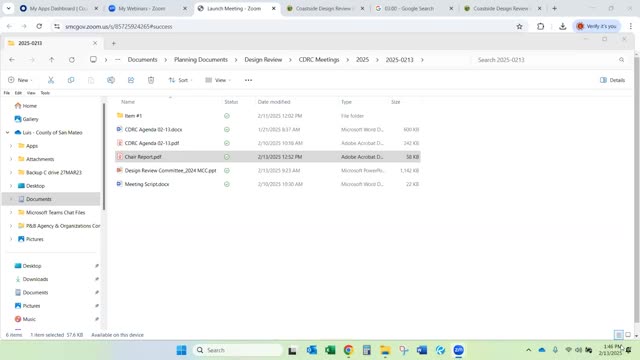Architectural changes to San Pedro project address design concerns and neighborhood standards
February 15, 2025 | San Mateo County, California
This article was created by AI summarizing key points discussed. AI makes mistakes, so for full details and context, please refer to the video of the full meeting. Please report any errors so we can fix them. Report an error »

In a recent Coastside Design Review Hearing held on February 13, 2025, in San Mateo County, discussions centered around the architectural design and compliance of a proposed residential project. The meeting, which drew attention from local residents and stakeholders, highlighted key concerns regarding the home’s design elements, particularly its perceived boxiness and elevation transitions.
As the meeting unfolded, the project’s architect presented a detailed analysis of the design adjustments made in response to previous feedback. The architect emphasized that the home’s architectural details were crafted to be proportional and complementary to neighboring properties. However, some attendees expressed concerns that the design still appeared too boxy and did not adequately step up with the natural grade of the land.
To address these concerns, the architect showcased photographs of recently approved homes in the area, illustrating that many had similar boxy characteristics yet received approval. This comparison aimed to establish a standard for what is deemed acceptable within the community. The architect also pointed out that their design incorporated various facade materials and features, such as siding and eaves, to soften the overall appearance and enhance visual interest.
A significant point of discussion was the home’s rear elevation, which was noted to be taller than other structures in the vicinity. The architect explained that the design included multiple setbacks, pushing the mass of the building further back from the property line, thus minimizing its visual impact on neighboring homes. The project was reported to exceed the required setbacks by a considerable margin, which the architect argued would create a better view corridor for adjacent properties.
Concerns were also raised regarding the project’s proximity to a riparian zone. The architect assured the committee that the foundation design, which included a grade beam and pier foundation, would comply with environmental regulations and avoid encroaching into sensitive areas.
As the hearing progressed, the committee members engaged in a constructive dialogue about the design’s compliance with local standards. They discussed the potential for further refinements, particularly regarding the decks that extended into the designated zones. Suggestions included cantilevering the decks and relocating downspouts to ensure they met the required setbacks.
The meeting concluded with a sense of cautious optimism as the architect expressed confidence that the design modifications addressed the committee's concerns. The project now awaits further review, with the hope that it will align with community standards while contributing positively to the neighborhood's aesthetic. As San Mateo County continues to navigate the balance between development and environmental stewardship, this project serves as a focal point for ongoing discussions about architectural integrity and community character.
As the meeting unfolded, the project’s architect presented a detailed analysis of the design adjustments made in response to previous feedback. The architect emphasized that the home’s architectural details were crafted to be proportional and complementary to neighboring properties. However, some attendees expressed concerns that the design still appeared too boxy and did not adequately step up with the natural grade of the land.
To address these concerns, the architect showcased photographs of recently approved homes in the area, illustrating that many had similar boxy characteristics yet received approval. This comparison aimed to establish a standard for what is deemed acceptable within the community. The architect also pointed out that their design incorporated various facade materials and features, such as siding and eaves, to soften the overall appearance and enhance visual interest.
A significant point of discussion was the home’s rear elevation, which was noted to be taller than other structures in the vicinity. The architect explained that the design included multiple setbacks, pushing the mass of the building further back from the property line, thus minimizing its visual impact on neighboring homes. The project was reported to exceed the required setbacks by a considerable margin, which the architect argued would create a better view corridor for adjacent properties.
Concerns were also raised regarding the project’s proximity to a riparian zone. The architect assured the committee that the foundation design, which included a grade beam and pier foundation, would comply with environmental regulations and avoid encroaching into sensitive areas.
As the hearing progressed, the committee members engaged in a constructive dialogue about the design’s compliance with local standards. They discussed the potential for further refinements, particularly regarding the decks that extended into the designated zones. Suggestions included cantilevering the decks and relocating downspouts to ensure they met the required setbacks.
The meeting concluded with a sense of cautious optimism as the architect expressed confidence that the design modifications addressed the committee's concerns. The project now awaits further review, with the hope that it will align with community standards while contributing positively to the neighborhood's aesthetic. As San Mateo County continues to navigate the balance between development and environmental stewardship, this project serves as a focal point for ongoing discussions about architectural integrity and community character.
View full meeting
This article is based on a recent meeting—watch the full video and explore the complete transcript for deeper insights into the discussion.
View full meeting
